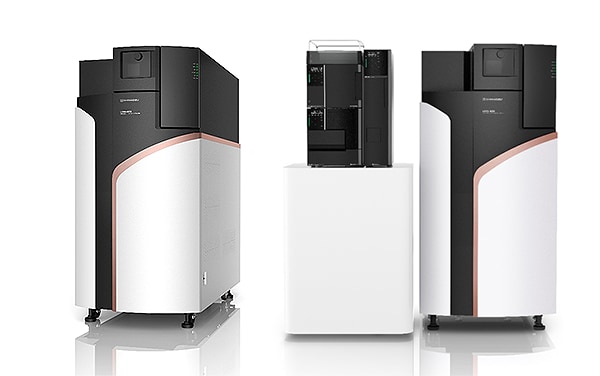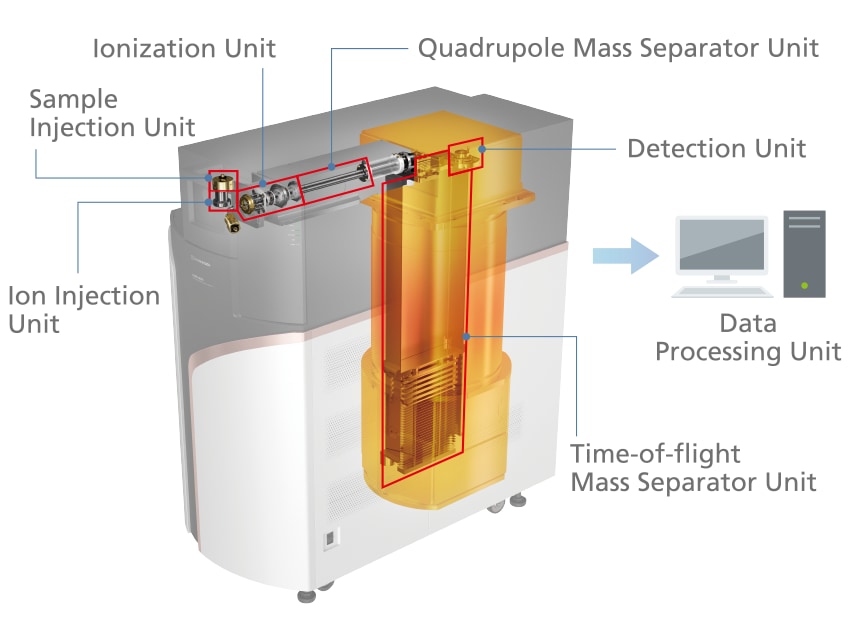July 29, 2022 | News & Notices
World’s Fastest Q-TOF Mass Spectrometer Capable of Simultaneously Measuring Positive and Negative Ions
Release of LCMS-9050 High-Performance Liquid Chromatograph Mass Spectrometer

(Left) LCMS-9050 Quadrupole Time-of-Flight (Q-TOF)Mass Spectrometer
(Right) Example of LCMS-9050 Combined with Nexera Ultra High Performance Liquid Chromatograph
Shimadzu has released the LCMS-9050 quadrupole time-of-flight (Q-TOF) high-performance liquid chromatograph mass spectrometer. Shimadzu first entered the Q-TOF mass spectrometers (MS) market in 2018 with the release of the LCMS-9030. The LCMS-9050 is the successor model to the LCMS-9030 and is our most advanced model, cutting previous analysis times in half while providing data with high reliability.
MS are analytical instruments used to investigate the types and quantities of substances contained in samples by separating sample substances down to the atomic or molecular level and then measuring the mass and quantity of respective atoms/molecules. The system consists of an injection unit that injects the sample, an ionization unit that ionizes the atoms/molecules, a mass separator unit that separates the ions by mass, a detection unit that detects the separated ions, and a data processing unit. Equipped with both quadrupole (Q) and time-of-flight (TOF) units for two types of mass separation, Q-TOF MS systems enable extremely accurate mass analysis. Mainly used by pharmaceutical manufacturers, chemical companies, universities, and research institutions, they are used for cutting-edge research applications that require high sensitivity, high speed, and high mass resolving power in addition to high accuracy. However, though previous Q-TOF MS systems offered high accuracy, the complex design made it difficult to simultaneously achieve both high data reliability and short analysis times and required delicate handling and frequent mass calibration.*

Configuration of Q-TOF MS System
The LCMS-9050 enables simultaneous measurement of both positive and negative ions due to faster switching between mass separator voltages. Simultaneously measuring both positive and negative ions increases the amount of information obtained from each sample and increases data reliability, as required by pharmaceutical companies for developing new drugs and by chemical companies for developing new materials. The LCMS-9050 can measure both positive and negative ions faster than competing models and in half the time of Shimadzu’s previous system. Optimizing the heater and temperature sensor layout reduces mass calibration* frequency while providing high data reliability. Mass resolving power is also 1.5 times higher than the previous model. In addition, systems can be configured with a wide selection of Shimadzu instruments to optimize the system for specific applications. Shimadzu will continue offering solutions for new drug development by pharmaceutical companies and new material development by chemical companies that can be used according to specific customer needs.
With the LCMS-9050, Shimadzu offers an environment where highly reliable analytical data can be acquired more easily. Shimadzu will keep contributing to R&D and quality control needs in a variety of fields, such as pharmaceuticals, chemicals, foods, and environmental measurement, by continuing to expand and improve its MS product line.
Features
1. Fast, Stable Polarity Switching for Improved Throughput and Reliable Data
Because MS systems need to measure positive and negative ions at different voltages, the mass separator unit must be able to reliably control voltage for both polarities. In particular, because Q-TOF MS systems normally wait a longer period after switching between voltages to prevent any voltage fluctuations from affecting data, it has been considered too difficult to simultaneously measure both positive and negative ions during the same acquisition. LCMS-9050 systems prevent voltage fluctuations from affecting data with hardware designed to ensure stable voltage control and software featuring proprietary UFStabilization data correction technology. That enables simultaneous measurement of positive and negative ions and acquisition of highly reliable data at speeds faster than competitors and in half the time as the previous model. Simultaneous positive-negative ion measurements are especially useful for applications requiring the measurement of both positive and negative ions, such as for new drug development at pharmaceutical companies, new material development at chemical companies, or for compliance with food safety or environmental impurity regulations.
2. Outstanding Basic Performance Capabilities Designed for Easy Operation
Q-TOF MS systems need to offer reliable measurement accuracy. In other words, the data should not fluctuate even if the room temperature varies. If metal parts in the mass separator unit expand/contract by even a few dozen micrometers due to room temperature variations, it can affect data and normally requires recalibrating mass values. In the LCMS-9050, however, the heater and temperature sensor layout has been optimized to minimize the effects of external factors on data, resulting in reliable data for long periods without frequent mass calibration.* The system also offers 1.5 times higher mass resolving power than the previous model to enable even more accurate measurements. That means even biopharmaceutical and other macromolecule samples can be separated and confirmed accurately, which helps reduce the burden of data analysis operations.
3. Optional Units Enhance System Capabilities to Satisfy Customer Needs
The LCMS-9050 can be used in combination with a wide variety of Shimadzu’s unique optional units. For example, in combination with a DPiMS QT probe electrospray ionization kit, the system can be used to analyze micro sample quantities without pretreatment. In combination with an iMScope QT imaging mass microscope, optical microscope and mass spectrometer images can be displayed at the same time. Shimadzu is committed to offering a broad range of choices necessary for satisfying customer needs, especially for new drug development by pharmaceutical companies and new material development by chemical companies.
* Mass calibration refers to using the signal detected from analyzing a sample with known mass values to determine whether mass number calculations need to be corrected and to what extent.
For more details, visit
LCMS-9050


